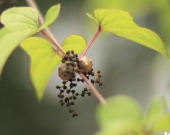posted 13 years ago
Hi Josh, I'm sorry to say I've been so busy with permies this week that I've not gotten to my e-mail. I often get requests for sources for edible air potato. I'm afraid I have to respond them all in the same way: air potato is illegal to grow or sell in the United States. With that said, yes there are people who grow it and I hope you bump into them. Some of them are in Florida. For those of you outside the United States, Las Canadas in Mexico has a wonderful nursery specializing in useful plants and they sell an edible clone of air potato. They cannot ship it to the United States. The USDA used to maintain a collection of elite air potato varieties in Puerto Rico, but got rid of all of them as well as the rest of their Dioscorea yam collection due to concerns over invasiveness. I think this was a major mistake as this genus is a major world food resource.
Air potato has a poisonous, extremely aggressive form as well as edible, better–behaved varieties. The poisonous form is a global weed and makes quite a nuisance of itself. The best thing I can say if you live somewhere where there is a lot of the poison form is that you should gather the tubers to make ethanol, bioplastics, or some other processed non-food product.
The edible forms of air potato are, again, quite a bit less aggressive. The shape of the aerial tubers varies enormously, reflecting the great genetic diversity that comes from having an native range that stretches from Africa to Australia. Some forms are slightly bitter while others are quite wonderful. What is phenomenal and virtually unique about this crop is that it makes very large amounts of tubers on the vine meaning it is a no–till perennial staple crop which can be stored for months. Productivity can be very high, as much as 19 metric tons per year, which is about the same as the global average for potatoes.
I would refer permies to Frank Martin's Tropical Yams and Their Potential, a detailed look at the genus Dioscorea. It is a USDA publication and can be tracked down through many libraries, though I hope to scan it and put it up on my website soon. Virtually everything you can find on the web about air potato is about how to kill it. I'm doing my best to tout the carbon–sequestering benefits of this absolutely unbelievably fascinating species. Even if it were only to be grown in its native range, the best forms of this species should be widely spread and cultivated as part of a coordinated effort to slow climate change.
Once again, the wild weedy form is very different and much more aggressive than the cultivated varieties. There are other species where this is also the case, for example the cultivated and sterile crop chufa is a form of the global weed yellow nut sedge.
I think we need to advocate to remove the ban on cultivating air potato (and certain other useful “invasive” species), in controlled experiments. When compared with the ecological cost of our current form of industrial food production, the ecological cost of growing non-–aggressive varieties of air potato doesn't look so bad to me. Of course we want to begin with growing the native species of a given area. The best native tuber crop in Florida is probably the groundnut, of which improved varieties are available from several nurseries including Oikos Tree Crops. Florida is also home to some other interesting native root crop species like spurge nettle (stings!) and Florida betony. However, all of those species require tillage for harvest and are thus inferior to air potato in terms of low maintenance and carbon sequestration. Some of the other Dioscorea species also produce aerial tubers, though none as heavily as air potato to my knowledge.






